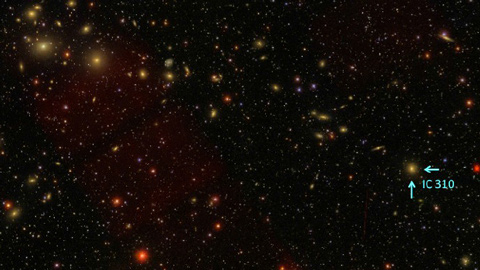Flare of Gamma Radiation in Galaxy IC 310 Originated from Black Hole’s Event Horizon
A flare of electromagnetic gamma radiation from the black hole in the galaxy IC 310 has revealed new information about the production of gamma radiation. The researchers from Tuorla Observatory at the University of Turku, who are part of the research project, say that the discovery is significant.

IC 310 is one of the thousand of galaxies in Perseus
An international group of scientists revealed that they have observed a powerful flare of very high-energy gamma radiation from the galaxy IC 310. The galaxy was studied with the MAGIC twin 17 meter telescope on the Canary Island of La Palma.
– Tuorla Observatory has been part of MAGIC since the beginning. In the ten years that we have been exploring space with MAGIC, we have made several surprising observations about high-energy universe which have required us to revise the existing theories, says the Coordinator of the MAGIC extragalactic research group Elina Lindfors, who is also Postdoctoral Research Fellow at the University of Turku.
The observations of the MAGIC telescope were combined with those of the radio telescopes of the European VLBI network. The telescopes showed clearly how a plasma jet emerged from the vicinity of a supermassive black hole at the center of the galaxy and, within that black hole, from a compact core smaller than a light year.
According to the Professor of Astronomy Juri Poutanen at the University of Turku, the location of the source of gamma radiation in active galaxies has been debated for at least two decades.
– It has been suggested that gamma radiation forms either very close to the black hole or even tens of parsecs away from them. The new observations of the rapid changes in the gamma radiation give strong support to the models that place the source close to the black holes and help us to understand the mechanisms of gamma ray production, says Poutanen.
One Parsec corresponds to 3.26 light years.
”We Knew We Had Discovered Something Significant”
The finding supports the idea that the flare emerges from a narrow region in the event horizon of the black hole from where they are pushed forward by strong magnetic fields. Such structures are expected to form near rapidly-spinning black holes.
– When the observation was made, the MAGIC collaboration was by chance having a meeting at La Palma. The next morning, when the news spread about the night’s finding, the excitement was tangible. We knew we had discovered something significant, says Lindfors.
Supermassive black holes, with masses ranging from a million up to few billion times the mass of the Sun, are thought to reside in the center of galaxies. This appears to be the case for IC 310.
However, the angular resolution of astronomical telescopes is usually not sufficient to observe the black holes directly, but by combining the MAGIC telescope’s observation on the rapid changes in gamma radiation and the radio shower observations of the European VLBI network, of which the Metsähovi radio telescope of Aalto University is a part of, the researchers got an unprecedentedly clear image of the close vicinity of a black hole.
The discovery was published in the Science Express journal
>> Science Express
>>watch the video
Text: Erja Hyytiäinen
Photo: research group: research group
Translation: Mari Ratia